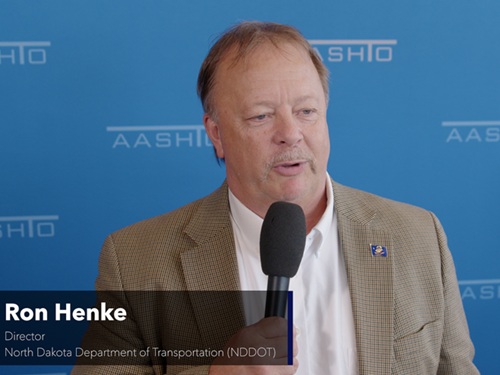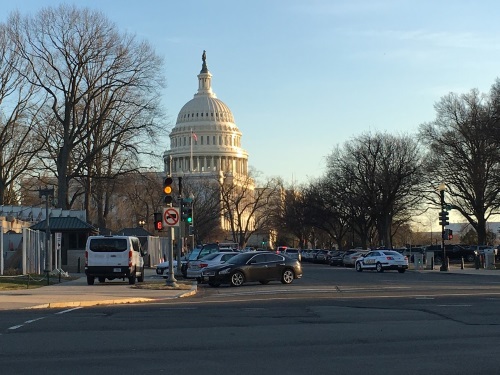A slate of private sector witnesses highlighted the benefits and challenges encountered during the implementation of the now year-old $1.2 trillion Infrastructure Investment & Jobs Act or IIJA during a Senate hearing on November 30.
[Above photo by AASHTO]
“America’s network of roads and bridges is the foundation of the U.S. economy, delivering the national connectivity envisioned by the U.S. Constitution,” Dave Bauer, president and CEO of the American Road & Transportation Builders Association, explained in his testimony before the Senate Committee on Environment and Public Works. “The IIJA, signed into law November 2021, enhances this vision.”

He stressed that the IIJA “should not be undersold” as a “half-measure,” but rather as a down payment for the nation’s future. “The five years of funding enabled by the infrastructure law will supercharge the long-term modernization of roads, bridges, airports, drinking water, and energy systems,” Bauer said. “Nearly half of the IIJA’s generational investment—nearly $450 billion—will be spent improving highways, bridges, and public transportation systems; an increase in nominal highway funding is the largest in more than 50 years.”
He went on to emphasize that formula funding provides a key bedrock for translating those funds in transportation improvements.
“The foundation of the federal-state partnership that is responsible for the nation’s network of highways and bridges are the formula programs, which provide state-focused, flexible, and recurring revenue,” Bauer said. “These different categories of federal support allow national needs to be pursued in a manner that respects the unique challenges and demands of each individual state. Nearly nine out of every 10 dollars spent on highways and bridges under the IIJA will be directed via formula; $303 billion over five years.”

He explained that the “good news” is that state transportation agencies have initiated more than 29,000 improvement projects in 2022 in part due to IIJA funding; some 2,500 more than in 2021.
“Thirty-seven states saw an increase in the number of federal-aid projects supported in fiscal year 2022, and more large projects were advanced in FY 2022 compared to FY 2021,” Bauer added. “The number of large projects receiving federal support of $50 million or more increased by over 50 percent. In total, 105 projects across 29 states saw $50 million-plus in federal investment compared to just 69 projects in 25 states in FY 2021.”
Overall, Bauer emphasized that the “key takeaway” from the first year of the IIJA is that the law “is working as intended,” with state DOTs disbursing their funds and projects breaking ground in communities across America.
“A virtue of the multi-year surface transportation reauthorization is the economic benefits that will follow project completion – be it increased state and local tax revenue, local job creation, or a boost to household income – are only set to compound from where we are today,” he noted.

However, Ali Mills, president of highway and bridge building firm Plum Contracting – who testified on behalf of the Associated General Contractors of America – stressed that inflation and “Buy America” rules are posing challenges where the acquisition of construction materials is concerned.
“The construction industry is facing material challenges that reach far and wide, with material price increases doubling even tripling in some cases,” she explained in his testimony. “Supply chain disruptions from the pandemic have inflated the cost of construction materials and made project delivery schedules and product availability more uncertain. As a result, crucial infrastructure projects across the country run the risk of delay. Construction firms, in situations where they are able to, will pass along the rising materials prices in order to remain successful.”
Added to that stress are new “Buy America” rules that Mills said the U.S. Department of Transportation and Office of Management and Budget are implementing despite confusing and oftentimes contradictory guidance. “It appears as though they are choosing to charge full speed ahead amidst supply chain woes – like long lead times and material allocations,” she stressed. “Put nicely, implementation of the new ‘Buy America’ requirements is off to a rocky start and the construction industry is very concerned and confused.”

Gary Johnson, vice president for the Land and Quarry Granite Construction Co., echoed those worries in his testimony on behalf of the National Stone, Sand & Gravel Association.
“Keep in mind that certain geographic areas of the county do not have the geologic deposits that allow local sourcing of stone, sand, and gravel to make concrete and asphalt and to be used in construction,” he explained.
“These materials must be imported from nearby countries and often it is less costly and produces less air emissions than trucking long distances across U.S. regions,” Johnson said. “Likewise, a lack of cement capacity in the states means cement must be imported. The lack of asphalt oil production and refineries, especially on the east coast, requires agencies and contractors to import from Canada to meet demand for basic street-paving materials.”
He also noted that aggregate suppliers across the country crave “certainty” as they work to supply billions of tons of essential materials needed to improve roads; upgrade bridges; advance transportation systems and ports; and build energy infrastructure funded via the IIJA. “This is especially important in the current economic environment, where needless red tape will delay project implementation and drive-up costs of construction materials,” Johnson noted.
Meanwhile, two electric vehicle firms at the hearing stressed the key role played by the IIJA is spurring the development of EV recharging infrastructure across the United States – especially via state departments of transportation.

“The $7.5 billion in funding for charging and alternative fuel infrastructure is a major step towards expanding charging infrastructure to support a growing EV market across the U.S.,” noted Jonathan Levy, chief commercial officer for EVgo, in his testimony. “If properly implemented, it will create thousands of well-paying jobs in manufacturing, installing, operating and maintaining charging stations in every state. But to be most effective, infrastructure policy should be paired with actions to stimulate EV sales on the consumer side.”
He also noted that while the first iteration of IIJA EV infrastructure funding aims to “help assuage the range anxieties of EV drivers” on trips or between cities and across the country, attention is also needed on community charging to ensure an equable transition to a decarbonized transportation system for all Americans.
“The federal government is uniquely positioned to accelerate transportation electrification by leveraging significant private capital via public/private partnerships,” Levy added. “Federal support can reduce private sector risk of investing into early-stage markets and bring private capital off the sidelines. With respect to EV charging, federal policies should act as a market stimulant to incent credible charging companies to extend their infrastructure footprints ahead of when they otherwise might if based on EV sales alone.”

Concurrently, Matt Stanberry – managing director of market development Highland Electric Fleets – noted that the passage of the IIJA was a “watershed moment” for school bus fleet electrification, positioning the federal government to play a critical role in developing this niche within the overall EV market.
“[But] there needs to be a focus on market economics and leveraging private sector competition to drive down project costs and accelerate deployment,” he explained. “Success will require a program structure that focuses on accelerating deployment by encouraging competition and reducing uncertainty; incentive levels designed to put downward pressure on project costs; and an emphasis on encouraging cost share and private sector participation.”
Stanberry added that as the federal government rolls out new EV programs such as for school buses – especially those dealing with technology transitions – it should use its unique platform to build education and awareness, and it should design the programs to leverage the capacity of the private sector.
“In this way, it can create momentum so that the private sector can help fund the transition going forward,” he noted.
 Nation
Nation
North Dakota DOT Profiled in State DOT Update
July 3, 2025 Nation
Nation

